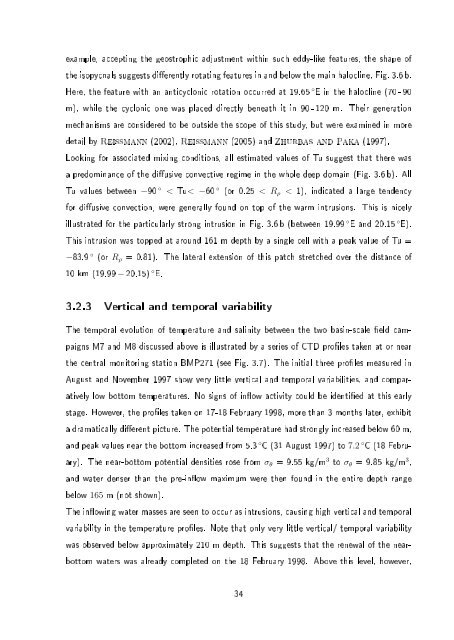Baltic Sea
Baltic Sea
Baltic Sea
You also want an ePaper? Increase the reach of your titles
YUMPU automatically turns print PDFs into web optimized ePapers that Google loves.
example, accepting the geostrophic adjustment within such eddy-like features, the shape of<br />
the isopycnals suggests dierently rotating features in and below the main halocline, Fig. 3.6 b.<br />
Here, the feature with an anticyclonic rotation occurred at 19.65 ◦ E in the halocline (70 - 90<br />
m), while the cyclonic one was placed directly beneath it in 90 - 120 m. Their generation<br />
mechanisms are considered to be outside the scope of this study, but were examined in more<br />
detail by Reiÿmann (2002), Reiÿmann (2005) and Zhurbas and Paka (1997).<br />
Looking for associated mixing conditions, all estimated values of Tu suggest that there was<br />
a predominance of the diusive convective regime in the whole deep domain (Fig. 3.6 b). All<br />
Tu values between −90 ◦ < Tu< −60 ◦ (or 0.25 < R ρ < 1), indicated a large tendency<br />
for diusive convection, were generally found on top of the warm intrusions. This is nicely<br />
illustrated for the particularly strong intrusion in Fig. 3.6 b (between 19.99 ◦ E and 20.15 ◦ E).<br />
This intrusion was topped at around 161 m depth by a single cell with a peak value of Tu =<br />
−83.9 ◦ (or R ρ = 0.81). The lateral extension of this patch stretched over the distance of<br />
10 km (19.99 − 20.15) ◦ E.<br />
3.2.3 Vertical and temporal variability<br />
The temporal evolution of temperature and salinity between the two basin-scale eld campaigns<br />
M7 and M8 discussed above is illustrated by a series of CTD proles taken at or near<br />
the central monitoring station BMP271 (see Fig. 3.7). The initial three proles measured in<br />
August and November 1997 show very little vertical and temporal variabilities, and comparatively<br />
low bottom temperatures. No signs of inow activity could be identied at this early<br />
stage. However, the proles taken on 17-18 February 1998, more than 3 months later, exhibit<br />
a dramatically dierent picture. The potential temperature had strongly increased below 60 m,<br />
and peak values near the bottom increased from 5.3 ◦ C (31 August 1997) to 7.2 ◦ C (18 February).<br />
The near-bottom potential densities rose from σ θ = 9.55 kg/m 3 to σ θ = 9.85 kg/m 3 ,<br />
and water denser than the pre-inow maximum were then found in the entire depth range<br />
below 165 m (not shown).<br />
The inowing water masses are seen to occur as intrusions, causing high vertical and temporal<br />
variability in the temperature proles. Note that only very little vertical/ temporal variability<br />
was observed below approximately 210 m depth. This suggests that the renewal of the nearbottom<br />
waters was already completed on the 18 February 1998. Above this level, however,<br />
34



